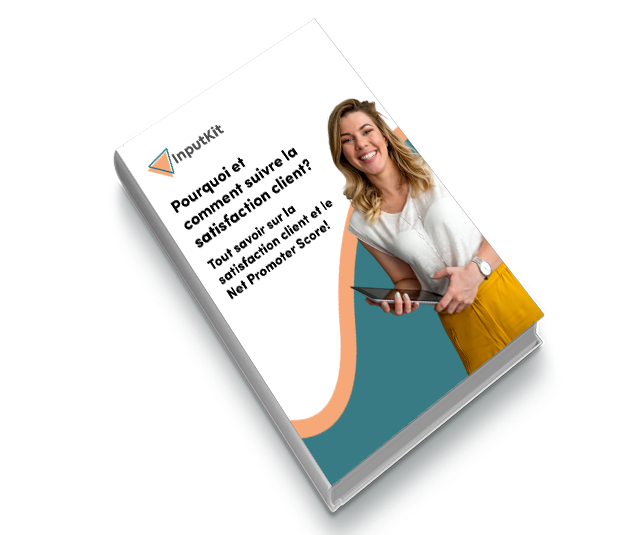As we explain in our article ‘The secret behind the effectiveness of customer feedback‘, customer feedback is really important for your company. The more feedback you obtain, the more accurate and useful it will be. That’s why you should focus on increasing the number of customers who leave feedback.
Download now : -> FREE FRENCH EBOOK All about customer satisfaction and Net Promoter Score
We’ve built this guide to help you increase your satisfaction survey response rate. If followed correctly, it’s possible to achieve around 40% response rate for business-to-consumer (B2C) and 60% for B2B enterprises (and even more!)
1. Prepare your customers
This is by far the most important and most neglected point.
When you are at the final meeting, or on the last call with your customers, tell them they’ll receive a quick ‘survey’. If it’s not possible in person or over the phone, you can use emails. The goal is to tell them that you gather feedback because you value their opinions, consistently make improvements to your services based on their feedback and that it will help you better serve them.
In fact, alerting your customers to expect a survey will make them more disposed to respond and increase response rates. By doing this, you not only come across as a very customer-centric organization but can also boost your survey response rates close to 100%!
2. Don’t wait too long
Your goal is to obtain your customers feedback about their recent experience, isn’t it?
Then, I guess you’d agree it’s better to ask for their feedback within a short period after their experience before they forget most of it, wouldn’t you?
Why then most businesses wait weeks or even months before asking for their feedback?
Because it’s less work for them…
Do not make that mistake.
When the experience is still fresh in the customer’s mind, they are more likely to respond and to give more precise and useful feedback. That’s why, ideally, you want to ask for their feedback as quickly as possible, within a few days of the experience/interaction.
3. Send a well-formed feedback request email
If you did the 2 steps above correctly, this step is not a deal breaker, but it’s still important. Basically, you’re just repeating what you said in the step #1.
Here’s the general template for the email:
- Why you are surveying
- What you will do with the results/how their feedback will be used
- What’s in it for them
Sender’s name
Send your survey from a human, not a department or company. What you need to know is that nobody wants to respond to a bot ([email protected]), they want to know that their input is being heard by an actual person. It should be a name they know or recognize. You can also include your company name next to it. For example: ‘Bob from company XYZ’.
43% of email recipients click the spam button based on the “from” name or email address so you need to ensure that it is known to your customer.
Subject
Keep in mind that most people will read your email diagonally, so it’s important that the subject line tells exactly what the email is about.
Here are good examples :
- How was our service – 5 questions
- [first name], we’d love to get your feedback
- [first name], we’d like to get your feedback to improve
- [first name], how did we do?
Content
Here are the best practices for the content :
- Your email should be personalized, using the customer’s name.
- Since the word “survey” often has a bad connotation, it’s generally a good idea to use the word ‘form’ or ‘questionnaire’ instead.
- Let them know how long the survey will take to complete.
- Use a strong call-to-action button, such as : “Share my opinion” or “Provide my feedback in 3 questions”
Using sentences such as “it would really help us out” can result in an increase in response rate up to 18 percent.
4. Quick and painless survey
Nobody like answering a survey, including your customers. That’s why you want to make yours as easy and quick as possible. You don’t want to overload the survey with unnecessary questions. Respect the fact that your customers are busy. Every question you ask is expensive. Expensive in terms of goodwill from your customer.
A solution is to truly understand your goal behind your survey and to focus on the 20% questions that could get you 80% of the results you want.
Your questions should be easy to read and easy to respond to. Also, don’t ask too many open-ended questions as they take longer to complete. One open-ended optional question at the end to get additional feedback is a good idea.
In term of amount of questions, we strongly suggest to ask under 10 questions, and ideally under 6.
Another good tip is to let your customers answer anonymously. It will increase your response rate while allowing more honest answers in some cases.
5. Send reminders
Following up increases your chances of a response by 58%.
It’s important to follow up with customers who did not answer yet. In general, sending up to three reminders gets you the best results.
Looking for a tool to get customer feedback?
We’ve built a modern tool called Inputkit to help businesses get feedback from their customers.
FREE FRENCH EBOOK
Why and how to monitor customer satisfaction?
All you need to know about customer satisfaction and the Net Promoter Score!



Related articles

Receive our best articles and tips by email
Be the first to know about our new articles.





